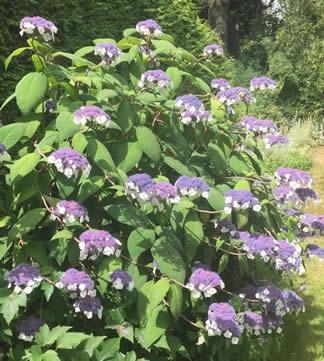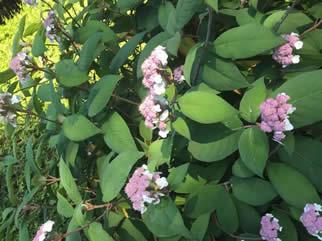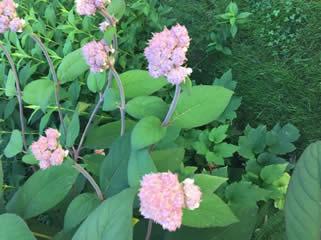Latin name: Hydrangea aspera
by Vancouver Island Master Gardeners Association
It is striking with its large, pointed, felted leaves, which display for the first part of summer, and then with its sumptuous multitude of elegant lace caps of violet blue for weeks following.
In 2006, Dan Pearson wrote an article for the Guardian newspaper entitled 'Hydrangea Opulence'. Even though as he said, hydrangeas have been "derided as the plumage of the seventies because of their ubiquity", they also "still pack the punch that wooed the Edwardians as nothing is quite as opulent in an August garden."
Besides this resounding claim to fame the Hydrangea aspera is also especially prized for its success in partial shade or north-facing gardens.
Large, fuzzy, pointed leaves in spring are followed by pink little bud bundles in mid-summer - a precursor to the multitude of elegant lace cap flowers of violet, white, and blue which decorate the plant from late summer into autumn - a "violet blue that hums at dusk", Pearson notes.



Photos courtesy of: Emmy Sampson.
|
Attribute |
Description |
|---|---|
|
Form: |
It is a large erect deciduous shrub. |
|
Foliage type: |
The leaves are up to 10 inches (25 cm) long, lance-shaped to narrowly ovate, simple and opposite. |
|
Height/Width: |
In ideal conditions, it can grow to 13 feet (4m+) tall and wide but typically grows to 10 feet (3m). |
|
Hardiness Zone: |
Zone 6 - 7 and it is not frost tender. |
|
Exposure: |
It grows well in sun or partial shade and likes to be sheltered from cold, drying winds. |
|
Flower colour: |
The violet blue, flattened fertile flowers are surrounded by white, sometimes pink to light purple, sterile flowers. The colour of the flowers are not affected by soil pH as are other hydrangeas. |
|
Leaf colour: |
Dark green. |
|
Flower time: |
Flowers from late summer to autumn. |
|
Preferred soil and Watering: |
The Hydrangea aspera grows best in moist but well-drained, moderately fertile, humus rich, acid or neutral soil. But it can tolerate most soils. It is the most chalk tolerant of the genus. |
| Pests & diseases: |
It is notable susceptible to honey fungus. |
|
Other: |
This plant is native to East Asia. The Latin meaning of 'aspera' is 'rough-textured' and refers to the downy surface of the leaves. Considerable natural variation occurs in the species, some of which are considered to be separate species. These include H. aspera ssp; sargentiana, and H. aspera ssp. villosa. All parts of the plant my cause stomach upset if ingested. Habitats include woodland garden sunny edge, dappled shade, and shady edge. It may be pruned in the spring to promote good leaf formation. Flower heads are pretty when dried. This hydrangea can be found close to the large firs beside the Viewing Platform at Milner Gardens & Woodland. |

